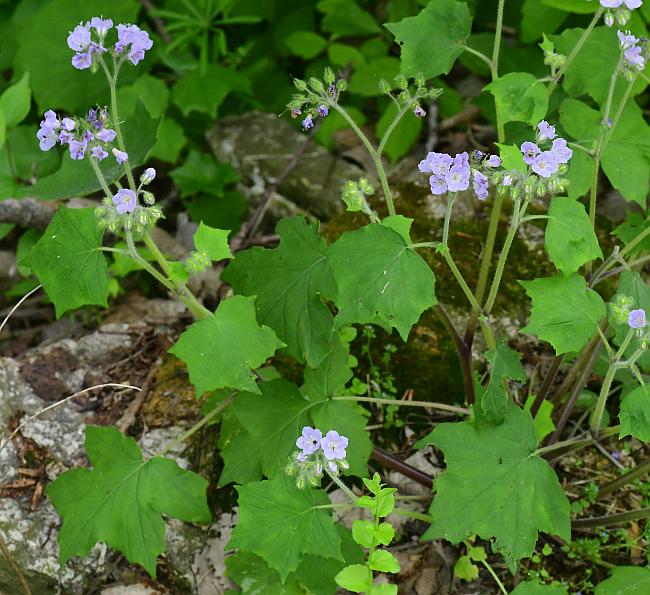Hydrophyllum appendiculatum Michx.
Woollen Breeches

Native
CC = 6
CW = 5
MOC = 64
© SRTurner
Hydrophyllum appendiculatum Michx.Woollen Breeches | |
 |
Native CC = 6 CW = 5 MOC = 64 |
© SRTurner |
|
Family - Hydrophyllaceae Habit - Taprooted, rhizomatous biennial forb. Stems - Ascending, to 60 cm, somewhat fleshy, single from the base, branching, pubescent with sparse to moderate longer and moderate to dense shorter, stiff spreading hairs.
Leaves - Basal and alternate, petiolate. Basal leaves with the blade 5-17 cm long, oblong to broadly elliptic in outline, pinnately compound or deeply lobed with 5-9 leaflets or lobes, these truncate or slightly narrowed at the base, the margins coarsely toothed, the surfaces sparsely to moderately pubescent with longer spreading and shorter more or less appressed, stiff, straight hairs, the undersurface pale green. Stem leaves with the blade 3-14 cm long, broadly ovate to nearly circular in outline, short-pinnately to more or less palmately and moderately to deeply lobed, the 5 or 7 lobes tapered from the broad base, the pubescence similar to that of the basal leaves.
Inflorescence - Terminal scorpoid panicle to 10 cm long, usually extending above the leaves. Peduncle hispid. Pedicels to 6-7 mm long, hispid.
Flowers - Calyces 4-8 mm long, the lobes bristly-hairy along the margins and with shorter hairs on the outer surface near the base, each sinus with a triangular appendage 1.0-1.5 mm long, this spreading to reflexed. Corollas 5-lobed, 9-14 mm long, bell-shaped to broadly bell-shaped, lavender to purple. Corolla tube to 4 mm long, glabrous. Stamens 5, adnate at base of corolla tube, erect, mostly included. Filaments white-lilac, 8-9 mm long, glabrous. Anthers lilac, to 3 mm long. Ovary superior, unilocular, with yellow nectary ring at the base, conic, 1 mm long, with erect white hispid pubescence. Style 7-8 mm long, glabrous, white to lilac. Stigma 2-lobed, 1 mm long. Stamens and style exserted only 1-3 mm beyond the corolla.
Fruits - Capsules 3-4 mm long, globose, moderately to densely hairy, at least toward the tip, 1-3-seeded. Seeds 2-4 mm long, broadly ovoid to nearly globose, the surface with a fine network of ridges, light to dark brown or reddish brown.
Flowering - April - July. Habitat - Bottomland and mesic forests, bases of bluffs, quarries, slopes. Origin - Native to the U.S. Lookalikes - H. virginianum; vegetatively, H. canadense. Other info. - This species can be found throughout Missouri, most frequently in a diagonal band running from the southeast corner of the state toward the northwestern corner. Beyond Missouri it ranges across the U.S. Midwest and into Canada. It is recognized by its somewhat maple-like leaves and lilac flowers which are held above the foliage. The leaves are lobed but not divided to the midvein. Vegetatively the distinction from H. canadense can be difficult. Several subtle leaf characters have been proposed to enable this differentiation but these do not seem to be consistently reliable across populations. Photographs taken at Weston Bend State Park, MO., 5-12-01 (DETenaglia); also at Shaw Nature Reserve, Franklin County, MO, 4-27-2010, Weldon Spring Conservation Area, St. Charles County, MO, 5-4-2011, Faust County Park, St. Louis County, MO, 4-4-2012 and 5-2-2016, the Al Foster Trail near Glencoe, St. Louis County, MO, 3-21-2016, Washington State Park, Washington County, MO, 4-24-2017, near Labadie, Franklin County, MO, 5-3-2020, and along the Katy Trail near Marthasville, Warren County, MO, 5-24-2020 (SRTurner). |